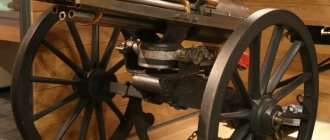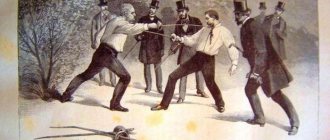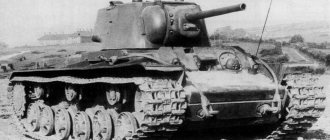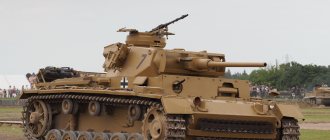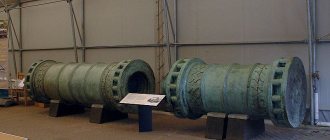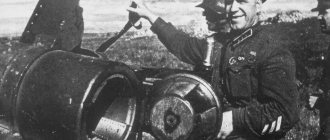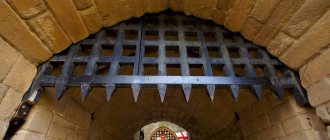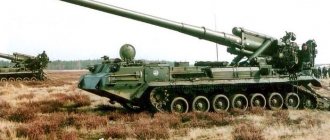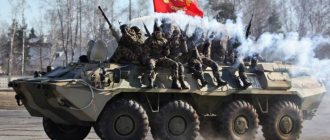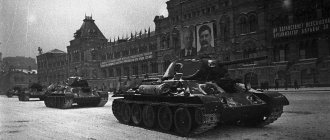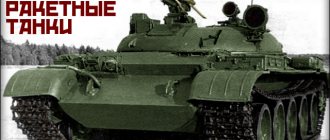Type Light half-track artillery tractor
| Sd.Kfz.2 Kettenkrad HK 101 | |
| Kettenkrad in Russia, winter 1943/44. | |
| Type | Light half-track artillery tractor |
| Place of origin | German |
| Service history | |
| In service | 1941–1945 |
| Used | Nazi Germany |
| Wars | The Second World War |
| Production history | |
| Designer | NSU |
| Developed | 1939 |
| Manufacturer | NSU Motorenwerke |
| Produced | 1939–1948 |
| Characteristics | |
| Weight | 1,560 kg (3,440 lb) |
| Length | 3 m (9 ft 10 in) |
| Width | 1 m (3 ft 3 in) |
| Height | 1.2 m (3 ft 11 in) |
| Crew | 1 driver |
| Passengers | 2 passengers |
| Engine | Opel four-cylinder in-line engine, water-cooled, 36 hp. (26 kW) |
| Transmission of infection | 3 forward / 1 reverse × 2 ranges |
| Maximum speed | 70 km/h (44 mph) |
Sd.Kfz.2
(Sonderkraftfahrzeug 2) is a half-track motorcycle with a single front wheel, better known as
the Kleines Kettenkraftrad HK 101
or
Kettenkrad
for the short (plural Kettenkräder, where Ketten means "chain" or "track" and Krad is the military abbreviation of the German word Kraftrad, an administrative German term motorbike).
Design[edit]
The Kettenkrad began its life as a light tractor for airborne troops. The vehicle was designed to be delivered by Junkers Ju 52 aircraft, but not by parachute. The vehicle's advantage was that it was the only artillery tractor small enough to fit in the hold of a Ju 52, and was the lightest production German military vehicle, using the complex overlapping and interleaved Schachtellaufwerk road wheels used on almost all German military half. tracked vehicles from the Great Patriotic War.
The Kettenkrad was controlled by turning the steering wheel: up to a certain point, only the front wheel could steer the vehicle. Moving the steering wheel beyond this point would engage the track brakes to make turns tighter. It was also possible to drive the vehicle without the front wheel mounted and was recommended in extreme off-road conditions where speed remained low. [1]
The Sd.Kfz.2 was designed and built by NSU Werke AG in Neckarsulm, Germany. Patented in June 1939, it was first used during the invasion of the Soviet Union in 1941. [2] Later during the war, Stoewer of Stettin also produced Kettenkrad under license, accounting for about 10% of total production. [3]
The Kettenkrad came with a special Sonderanhänger 1 (Sd.Anh.1) trailer that could be attached to it to improve its carrying capacity. The trailer carried 350 kg.
The Kettenkrad was a tracked vehicle, so it could climb up to 24° on sand and even more on hard surfaces.
The most unusual combat motorcycles in history
Self-propelled two-wheeled vehicles appeared back in the 60s of the 19th century; initially, a steam engine was installed on them.
These were the most distant ancestors of modern motorcycles. The first motorcycle with an internal combustion engine was built by German engineers Wilhelm Maybach and Gottlieb Daimler in 1885. Both engineers are the founding fathers of two major automobile brands that are still known throughout the world today. Gradually, motorcycles developed, improved, and by the beginning of the First World War they reached a level that attracted the attention of the military of many countries. It is worth noting that before the start of the First World War, the horse remained the main means of transportation in all armies. Horses were used in armies in huge numbers, but they required daily care, they had to be fed and watered. For example, in the Russian Imperial Army in 1916, 50 percent of all food cargo was horse feed: oats, hay, feed straw. These were millions of pounds of cargo, which were not only heavy, but also took up a lot of space. The advent of mechanized vehicles greatly simplified logistics, and they could not be treated like a living creature.
Motorcycles were especially popular with infantry, signalmen and messengers. During the First World War, motorcycles underwent a baptism of fire and began to be used quite massively. They were used for courier communications, terrain reconnaissance, as a means of quickly transporting small loads, and in some cases as combat vehicles. Over time, weapons, small armor and camouflage paint began to appear on motorcycles. By the beginning of World War II, motorcycles were already widely used by all armies of the world, and the image of a German soldier on a motorcycle with a sidecar became a textbook example. Over time, designers began to offer unusual designs for combat motorcycles, even armored monsters. Let's look at the most interesting of unusual projects.
Armored motorcycle projects
The idea of equipping a motorcycle with a machine gun and minimal armor was proposed by Frederick Richard Simms back in 1898. This man, in fact, also founded the entire automotive industry in Great Britain. The project he created was something like a motorized wheelchair with a machine gun on board, which was covered with an armored shield. In modern terminology, his invention would be called an ATV. He mounted a 7.62 mm Maxim machine gun on it. A notable feature of the development, called Motor Scout, was that, if necessary, the driver-gunner could switch exclusively to pedal traction.
During the First World War, motorcycles began to receive weapons en masse.
In the armies of many countries, models appeared with a machine gun mounted in the stroller, which was covered in front by an armored shield. At the same time, the Russian Imperial Army also designed a self-propelled anti-aircraft gun based on a motorcycle. This model did not have any reservations. At the same time, a standard Maxim machine gun was placed in the carriage on the installation for conducting anti-aircraft fire. After the end of the First World War, one of the most powerful and heaviest motorcycles with a sidecar, the American Harley Davidson, became the basis for the creation of armored bicycles for many years. In the USA, back in the 1930s, police officers wanted to acquire motorcycles with armor. Apparently, it was due to the need to resist the gangsters who had received numerous Thompson submachine guns at their disposal. In fact, these motorcycles were ordinary versions of Harleys with a sidecar, on which armored shields with bulletproof glass inserts were installed on the front. The shields were similar to those used today by special forces during assaults and hostage rescues.
Motorcycle reservation option for American police
Much more advanced versions of armored bikes were designed in Europe in the 1930s. The Belgian and Danish militaries considered the possibility of using such equipment in a combat situation. Thus, the famous Belgian company FN (Fabrique Nationale) in 1935 created an armored bike for the Belgian army, designated FN M86. The model for the armed forces received an engine boosted to 600 cc and a reinforced frame. However, even such an engine, which produced 20 hp, gave in to additional armor, the weight of which reached 175 kg. The driver covered himself in front with a massive armored shield, which had a window. In a combat situation, the window was closed and it was possible to monitor the road through the viewing slot. The shooter in the wheelchair was protected by armor on three sides.
Armored Moto FN M86 armored bike at the parade in Sao Paulo
The military were not satisfied with the running capabilities of the motorcycle. The speed and maneuverability of the heavy vehicle left much to be desired. However, FN was successful in the international market. The model was sold to the Brazilian police under the designation Armored Moto FN M86. Both built motorcycles, as well as all the technical documentation for their production, went to Brazil. Moreover, other Latin American countries, as well as Romania and Yemen, later purchased such armored bikes. True, all the batches were small; in total, about 100 of these motorcycles were produced.
The engineers of the Swedish company Landsverk went even further, who built the Landsverk 210 armored bike for the Danish army. The model was created in 1932 on the basis of the Harley Davidson VSC/LC motorcycle. On this model, the driver was covered with armor not only from the front, but also from the back, and also partially from the side. At the same time, the armor protected the motorcycle itself, all important components and assemblies, and even partially covered the wheels. In Denmark the model was called FP.3 (Førsøkspanser 3). However, the military was not impressed by the model; it was very difficult to control the motorcycle, and it skidded a lot at speed. A powerful 1200 cc engine, developing up to 30 hp, did not save the situation, since the mass of armor and weapons placed on the model exceeded 700 kg.
Armored bike Landsverk 210, FP.3
Grokhovsky's armored bike
During the interwar period, the Soviet designer and engineer Pavel Ignatievich Grokhovsky proposed his own design for an armored combat motorcycle or simply an armored bike.
Pavel Grokhovsky was primarily an aircraft designer and worked in the interests of the newly emerging airborne troops. As we already know, he was not a pioneer in the creation of an armored vehicle; similar ideas were widely considered by the military of many countries in the 1930s. The designers offered numerous options for single-seat armored vehicles, as well as armored motorcycle models with a sidecar and machine gun armament. Grokhovsky’s armored bike differed from the developments of foreign designers primarily in the presence of a full-fledged armored hull that protected the fighter from all sides. Grokhovsky's armored vehicle was a small single-seat armored vehicle on a half-track chassis with a motorcycle-type front swivel wheel. The caterpillar mover was distinguished by the presence of only one belt, as well as two support wheels of small diameter on the sides. The armor is light, providing protection for the fighter and vehicle components from small arms fire and small fragments. The armored hull covered the entire motorcycle. The driver of the armored vehicle simultaneously served as a gunner, firing from a machine gun mounted in the front hull. The driver's seat was in a closed armored cabin at the front of the vehicle, followed by the engine and transmission compartment. To observe the terrain, the driver used viewing slots in the vehicle’s body, as well as a hemispherical turret on the roof of the body.
Grokhovsky's armored bike. Rice. A.Shepsa
Grokhovsky's armored bike was worked out in detail, but the military was not interested in the project, so it was never realized in metal. It’s a pity, considering that Germany’s own version of the half-track motorcycle appeared and was widely used during the Second World War, although it was a variant without armor, which proved to be an effective lightweight tractor-transporter. At the same time, like Grokhovsky’s armored vehicle, the German SdKfz 2 was created primarily for airborne troops.
Half-track motorcycle SdKfz 2
The German half-track motorcycle SdKfz 2 is rightfully considered one of the most interesting, and most importantly effective and sought-after examples of unusual combat motorcycles. This model became one of the heroes of the Hollywood film “Saving Private Ryan.”
Mosfilm is not lagging behind in this regard; SdKfz 2 is also presented in the Russian film “Star”, in which a Soviet reconnaissance group encounters a German patrol on a half-track motorcycle. From 1940 to 1945, 8871 such motorcycles were assembled in Germany, and after the end of the war, approximately 550 more machines were built from the existing stock. This model was developed as a transporter and half-track tractor for parachute and mountain ranger units. The vehicle was planned to be used as a light artillery tractor. At the same time, the undeniable advantage was that the motorcycle could be easily transported directly on board the main German military transport aircraft Ju-52. During the war, the half-track motorcycle found use in all parts of the German army. It was usually used to transport light artillery pieces: mountain and anti-aircraft guns, small-caliber mortars, and various trailers. The SdKfz 2 could also be used as a cable layer and even an aircraft tug at airfields.
Separately, we can highlight the fact that one of the factory delivery options was mounted armor, after installing which the half-track motorcycle turned into a combat reconnaissance vehicle armed with a machine gun. True, such a modification significantly increased the weight of the motorcycle, which negatively affected the speed characteristics and cross-country ability of the SdKfz 2. In the usual version, the SdKfz 2 half-track motorcycle could move over rough terrain at speeds of up to 40 km/h, and on the highway it could reach 62 km/h . At the same time, the standard carrying capacity of the model was 350 kg, the crew was up to three people.
Anti-tank scooter
One of the craziest projects in the history of military motor vehicles can be called the French anti-tank scooter Vespa 150 TAP.
The model was built serially and was produced in commercial quantities - from 500 to 800 pieces. The unusual scooter was specially designed for French paratroopers and was a carrier of an American-made 75-mm M20 recoilless rifle. When creating this model, the designers took as a basis the Italian Vespa scooter with a single-cylinder two-stroke gasoline engine. The main advantage of this solution was mobility; the speed of the scooter on paved roads reached 66 km/h. At the same time, its frame supported the weight of the American M20 recoilless rifle, which, although not the crown of creation, still penetrated 100 mm of armor with the help of cumulative projectiles.
Vespa 150 TAP
These combat scooters were supposed to be used in pairs. On one the recoilless rifle itself was mounted, on the other the shells were transported to it. Two paratroopers, having such means at their disposal, had to effectively fight the enemy’s light armored vehicles. To fire, the recoilless rifle was naturally removed from the scooter and placed on a machine reminiscent of the machine gun for the M1917 Browning machine gun. At the same time, in an emergency, it was possible to shoot directly from a scooter, however, one could forget about the accuracy of shooting.
Service [edit]
Kettenkräder with trailer Sd.Anh.1, Russia 1943.
Most Kettenkräder saw service on the Eastern Front, where they were used to lay communications cables, tow heavy loads, and transport soldiers through deep Russian mud. Later in the war, Kettenkräder were used as runway tugs for aircraft, especially the Messerschmitt Me 262 jet fighter, and sometimes the Arado Ar 234 jet reconnaissance bomber. To save aviation fuel, German jets were towed to the runway rather than taxiing under their own power.
The vehicle was also used in the North African Theater and on the Western Front.
NSU Kettenkrad HK 101 SdKfz 2
This entry is also available in: English Chinese
Audio version of the article:
Motoryriada No. 20
Test drive video
In 1940, ]Neckarsulmer Fahrzeugwerke, AG[/anchor], located in Neckarsulm, received an order from the Ministry of Armaments of the Army (Heereswaffenamt) to develop a light tractor designed to increase the mobility of infantry units, conduct reconnaissance, tow light artillery systems and others military cargo.
The NSU Kettenkrad HK 101 SdKfz2 was equipped with a 4-cylinder, in-line Opel Olympia petrol engine producing 36 hp. at 3400 rpm. The transmission included a dry single-plate clutch, 3-speed gearbox, range and double differential. The chassis included a front steered wheel in a motorcycle-type fork and a caterpillar propulsion unit mounted on a supporting welded body, consisting of five dual rubber-coated rollers, a front-gear drive wheel and a 170 mm wide chain belt with rubber cushions. There was a driver's seat in the front part of the car's hull, and two more seats were equipped in the rear part of the hull. The tracked motorcycle had no weapons.
On rough terrain, the car could move through mud and even through a swamp, thanks to the slight pressure on the ground. The weight of the motorcycle was 1235 kg. It could carry a load of 325 kg. and tow trailers weighing up to 450 kg. In addition to the driver, it could carry two more people. Fuel tanks with a total capacity of 42 liters, located on the sides of the driver’s seat, provided a range of 260 km. along the highway, and over rough terrain - 175 km. The maximum speed on the highway reached 62-70 km/h, and on rough terrain – 40-48 km/h. The vehicle with large turning radii was turned by turning the wheel; with small turning radii, the vehicle was turned by braking the track.
Due to their good maneuverability and reliability, as well as simplicity and ease of maintenance, the NSU Kettenkrad HK-101 SdKfz2 tracked motorcycles gradually spread to all ground forces, including armored units. They were one of the few means capable of operating in conditions of spring and autumn thaw on the Soviet-German front. The disadvantages of the car are a narrow track, complete vulnerability of the crew, as well as a tendency to capsize when driving along slopes and when making turns at high speed, and when capsizing, the driver almost never had time to leave the car. Drivers also complained about the high labor intensity of servicing the machine: it had 150 lubrication points alone.
The value of a copy of our collection lies in the fact that Ketenkrad was released during wartime - in 1944. Most of the vehicles of those years were either destroyed in battles or were used in such harsh conditions that they did not survive to this day.
For example, at the end of World War II, in order to save aviation fuel, planes were no longer allowed to drive onto the runway themselves - pulling them there became the job of the Kettenkrads, who often worked under serious overload.
| Manufacturer | Neckarsulmer Fahrzeugwerke, AG, Neckarsulm, Germany |
| Years of manufacture | 1940 – 1949 |
| Quantity, pcs | 9 420 |
| Price | 6 810 RM |
| Cost in modern prices | 44 017,9 $ |
| ENGINE AND TRANSMISSION | |
| Type | Opel Olympia, carbureted, 4-cylinder in-line liquid-cooled engine |
| Engine volume, cm3 | 1 478 |
| Piston diameter and stroke, mm | 80 x 74 |
| Power | 36 hp at 3400 rpm. |
| Ignition | starter |
| Carburetor | Solex, 32FJ-II |
| Battery | 6V |
| Clutch | dry single-disc |
| Transmission | 3-speed |
| FRAME AND WHEELBASE | |
| Frame type | |
| Front suspension | parallelogram motorcycle type with large diameter disc wheel |
| Rear suspension | caterpillar mover mounted on a supporting welded body |
| Brakes | |
| Wheel sizes | 3.50 x 19 (front wheel) |
| DIMENSIONS | |
| Length, mm | 3 000 |
| Width, mm | 1 000 |
| Height, mm | 1 200 |
| Wheelbase, mm | |
| Ground clearance, mm | 230 |
| Seat height, mm | 800* |
| Weight, kg | 1 230 |
| Gas tank capacity, l | 42 (2x21) |
| Maximum speed, km/h | 70 |
| Range, km | 260 |
* – Data based on the results of measurements on the exhibit “Motorworld of Vyacheslav Sheyanov”.
